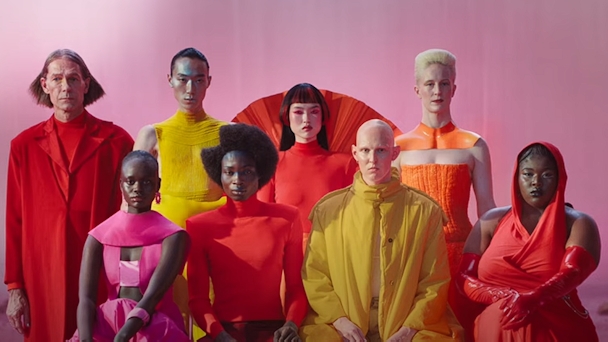Jaguar’s Miami EV launch invites new wave of criticism, but CCO says brand is undeterred
The British automaker unveiled two electric vehicles on Monday night in a flashy installation in Miami. The launch was accompanied by a keynote from the company’s chief creative officer Gerry McGovern, who reaffirmed Jaguar’s unwavering commitment to ‘exuberant modernism’ despite public backlash over the brand’s new direction.

The automaker is doubling down on its 'Copy Nothing' campaign despite its mixed reviews. / Credit: Jaguar
Jaguar doesn’t mind the haters.
The brand’s Monday night Miami Art Week installation wasn’t just another product showcase but a bold and unapologetic statement of purpose.
At the event, the automaker unveiled two new electric vehicle concepts, London Blue and Miami Pink (images of which leaked earlier on Monday). The designs are the centerpiece of the automaker’s new philosophy of ‘exuberant modernism.’
The new models arrive nearly two weeks after the brand ditched its sleek, iconic Jaguar logo in favor of a bright, contemporary rebrand that has proven highly controversial, with some labeling it “woke” or “out of touch.” Others, however, such as Steven Pearce, CEO of L36 Media Inc, saw the brazen new design and creative campaign as a pure engagement play ahead of the product launches. In an op-ed for The Drum, Pearce argued that Jaguar likely ”doesn’t care” about all the chatter online.
Want to go deeper? Ask The Drum
And Monday’s launch event made one thing clear: Jaguar is doubling down on its commitment to bold, unapologetic design and branding.
As chief creative officer Gerry McGovern told the audience on Monday evening, “controversy has always surrounded British creativity when it’s been at its best,” while referencing iconic British trailblazers such as David Bowie, Vivienne Westwood and Richard Rodgers.
Advertisement
The event spotlighted two striking EV prototypes. London Blue, inspired by Jaguar’s British heritage and the 1960s E-type roadster, offers a nod to the brand’s history. Miami Pink, meanwhile, captures the vibrancy and diversity of its namesake city. Both models feature Jaguar’s unique electric platform, boasting up to 430 miles of range and 1,000 horsepower.
McGovern positioned the new vehicle designs – as well as the refreshed brand more broadly – as both an embrace of modern sensibilities and a return to Jaguar’s roots. “When Jaguar was at its best, it threw away the car design rule book and created objects of desire,” he said. “Sir William Lyons, our founder, many years ago, said a Jaguar should be a copy of nothing.”
The exec spoke about “exuberant modernism” as a core design ethos and emphasized how the vehicles’ design breaks conventions in the electric vehicle market. “Look at its jaw-dropping proportions. That’s what we mean by ‘exuberance.’ Its long bonnet doesn’t conform to electric vehicle design and why should it?”
Advertisement
McGovern also explained the meaning behind Jaguar’s new branding elements, including the updated logo, a repeated strike-through motif symbolizing the brand’s desire to “strike through convention” and dramatic, tactile interiors designed to create a sense of occasion.
Despite the flashiness of the event, some branding experts remain unimpressed.
“Yes, the attempt and direction were daring, but so far, it hasn’t lived up to the dramatization,” says Reilly Newman, founder of branding consultancy Motif Brands. “British heritage was given a small nod with the color chosen for their prototype, but the leaping Jaguar now looks more like Puma’s leaping predator and the wordmark feels similar to the trend of ‘blanding’ seen in the fashion world.”
Jaclyn Hesse, co-founder of branding agency Taillight, was similarly critical.
“The rebrand feels forced, contrived,” she says. “The cars themselves, now that they’re actually showing them, recall elements from Audi’s E-Tron line and the boxy features of Toyota’s new Land Cruisers and 4Runners. It seems like change for the sake of change, a flailing attempt to stay relevant.”
Suggested newsletters for you
Hesse also questions the vehicles’ color choices, suggesting they were more about shock value than innovation: “To almost veil the attempts of industry plagiarism, it opted for pink because it’s loud, shocking. It says, ‘copy nothing’? To us, ‘copy everything’ seems more on brand.”
Even the decision to unveil the brand’s new direction onstage at Miami Art Week was criticized by some as a missed opportunity to highlight Jaguar’s heritage.
“The event tonight that the brand hyped up was a desperate attempt to pull an iconic Steve Jobs moment or maybe squeeze out a Tesla reveal moment,” says Newman. “Sadly, this didn’t work for the brand and only dug the hole deeper.”
Nonetheless, universal acceptance might not be what Jaguar is striving for, as evidenced by McGovern’s own remarks.
“Jaguar has no desire to be loved by everybody. It has already stirred emotions and it will continue to,” he said in an apparent allusion to the controversy swirling around the rebrand. “Some may love it now, some may love it later and some may never love it. And that’s OK because that’s what fearless creativity does.”
Whether Jaguar’s new chapter will resonate with a new generation of consumers or alienate its historic base remains to be seen, but the brand’s unwavering determination to ‘copy nothing’ leaves no question that it is ideologically committed to charting its own path.
